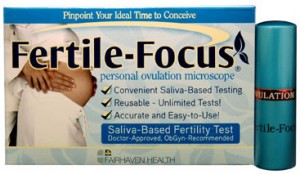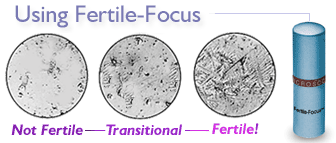
Fertility microscopes are one of the easiest tools you can use to pinpoint your most fertile times of the month. Compared to stick testing and charting, using a fertility microscope is also a more fun way to witness your hormonal transition towards ovulation.
The size of a lipstick container, this fertility tool has 97% accuracy in alerting you to ovulation up to 72 hours in advance. This allows you enough time to get you and your partner’s schedules coordinated 🙂 .
The Fertile-Focus fertility microscope allows you to identify you most fertile days by testing and viewing the visual changes that take place in saliva throughout your monthly cycle.
How it Works
Just prior to ovulation, women experience an “estrogen surge,” and a distinct fern-like pattern becomes visible in saliva due to the hormonal changes. Fertile-Focus provides the highest quality, powerful 50x magnification lens for easily identifying these crystal “ferning” patterns.
 To use Fertile Focus, simply place a drop of saliva from under your tongue on the lens. Once the sample has dried (typically within 5 minutes), press the LED light button and view resultant pattern through the lab-quality magnifying lens. If you are ovulating – or if you’re about to ovulate – a distinct “ferning” crystal-like pattern can be viewed. This is your indication that it’s time to make love for baby-making purposes!
To use Fertile Focus, simply place a drop of saliva from under your tongue on the lens. Once the sample has dried (typically within 5 minutes), press the LED light button and view resultant pattern through the lab-quality magnifying lens. If you are ovulating – or if you’re about to ovulate – a distinct “ferning” crystal-like pattern can be viewed. This is your indication that it’s time to make love for baby-making purposes!
Watch the video below on how to use this handy little gadget.





